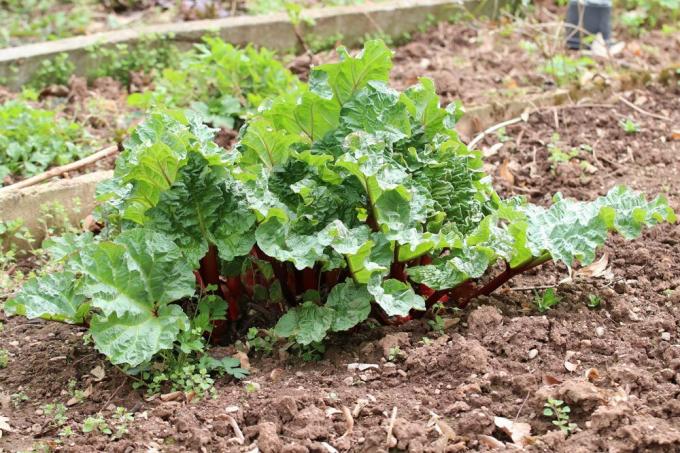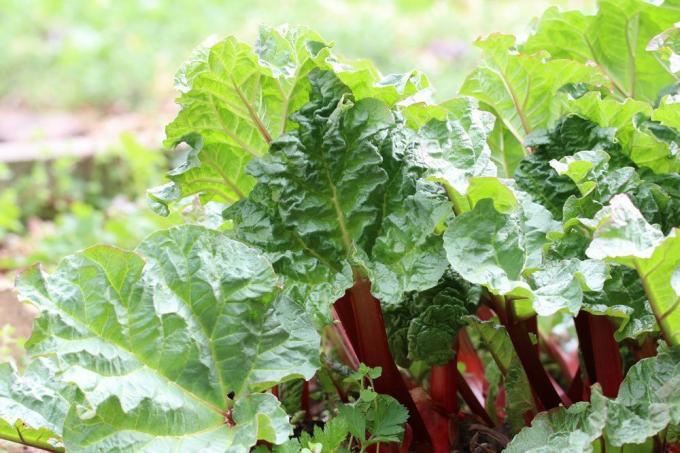
table of contents
- Plant rhubarb
- Planting time
- Plant spacing
- Planting rhubarb: instructions
rhubarb actually belongs to the leafy vegetables, but is most often used in desserts, such as cakes or jams. In the garden it is one of the easy-care plants. Rhubarb is grown permanently and stays in the same location for many years. With enough water and nutrients, there is an abundant harvest every year. Propagation is also easy, it is done using cuttings. What needs to be considered when planting is listed here.
Plant rhubarb
A favorable location for rhubarb plants is sunny or partially shaded. The soil should be rich in nutrients and well drained. Waterlogging is worse tolerated than sandy soils. Fully shaded locations are not so well suited, as the stems then remain very thin and the plants do not grow as vigorously. It is important that a location is chosen where the rheum rhabarbarum several years remain can. The space must be big enough, rhubarb shrubs become very expansive over the years.
Note: Full sun can sometimes cause the rhubarb to bloom more.
A good place is that compost. It can be transplanted with rhubarb and over time the unsightly pile disappears behind the plants, which grow larger every year. In addition, the rhubarb plants get the necessary nutrients for their vigorous growth right away.
Planting time
The best time to create a rhubarb patch is in autumn or spring. However, a rhubarb can also be planted in between at any time. Regardless of the point in time, the first takes place harvest always in the following year, or better still later. The plants should be able to grow well in the beginning and develop into sturdy perennials before they are harvested. That is why only a few stems are turned out and processed in the first few years.

tip: If an older rhubarb plant is to be divided, the correct planting time for the cuts is autumn. They have grown in by winter.
If rhubarb is grown from seeds, it can also be temporarily sown and cared for in a pot in spring. The best time is then March or April. However, rhubarb shrubs are difficult to maintain in pots over the long term, they simply become too big.
Plant spacing
With a few exceptions, rheum rhabarbarum becomes very large. After a few years it will take up at least one square meter of space. A distance of 130 cm makes the most sense. There should also be at least one meter of free space for other plants. One is possible Mixed culture with different vegetables, but even then the respective planting distance must be observed.
The correct spacing also depends on the type of rhubarb being used. There are species that remain small and varieties of rhubarb that develop stems that are over 90 cm long.
Growth sizes of individual varieties, according to which the space requirement then depends:
- Syruparber Canada Red: 60 - 80 cm
- Lowberry Lilibarber (small potted rhubarb): 10 - 20 cm
- Raspberry red: 60 - 80 cm
- Early Green: 60 - 80 cm
- Goliath: 120 cm
- Frambozen Rood: 100 cm
- Holstein blood: 90 cm
- The Sutton: 100 cm
- Canada Red: 100 cm
- Cambell: 90 cm
Planting rhubarb: instructions
- The soil of the selected planting site is prepared. For this, if it is uncultivated soil, it is deeply dug up. If there were other vegetables on the square before, it is sufficient to loosen them with the digging fork.
- Larger stones and weeds are removed. It is also dug under manure or compost. This is particularly important in sandy soils in order to improve the water storage capacity. You should expect about 3 liters of compost per plant.
- A planting hole is dug for each plant. It doesn't have to be very big. However, the soil should be loosened. If the soil is very heavy, such as clay soils, drainage made of gravel or gravel is worthwhile. When digging the holes for several plants, the correct plant spacing must be observed.
- The rhubarb plant is placed in the hole. The leaf base with the buds should be just below the ground. The hole is filled up again, the buds are covered with earth. Firmly press or step on the soil so that the roots get a good connection to the soil.
- The area around the rhubarb can be mulched, so that moisture is retained better and weeds are suppressed. In addition, nutrients are released during the rotting process. Lawn cuttings, leaves, chopped wood residues or compost are suitable for this. Rheum rhabarbarum prefers neutral soils, so the mulch material should not give off too much acid. Bark mulch is unsuitable.
- The plants are poured vigorously. The root area should not dry out in the near future either.
- The rhubarb plant can remain in the same place for 10 years, but it is worthwhile to rejuvenate and replant older plants beforehand.




